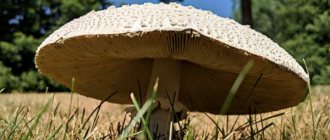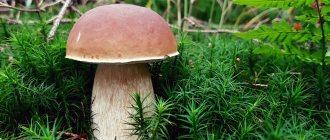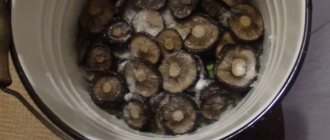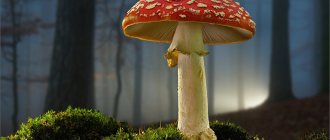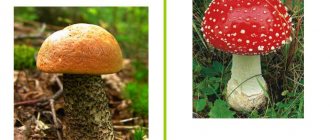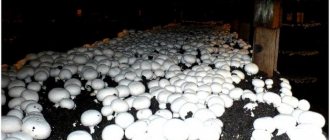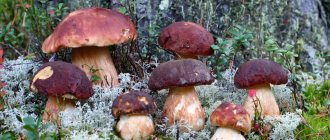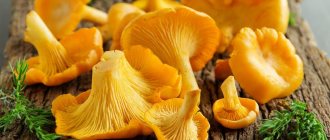Mushrooms
0
1350
Article rating
Kira Stoletova
Symbiont mushrooms are one of the most amazing forms of life. There are many types of organisms that can be called symbionts. The process of symbiosis in nature is important.
Features of symbiont mushrooms
You - for me, I - for you
In the world of wildlife, symbiosis is a kind of interaction between two organisms of different species, benefiting both of them. There are a huge number of examples of such symbiosis - from the famous friendship of hermit crabs with the coral polyp sea anemone, which settles on their shell and protects the crayfish from enemy attacks with its stinging threads in exchange for the ability to move along the bottom and find food faster, to bacteria that live in the digestive tract human system and ensuring us successful digestion and assimilation of food.
Mushrooms are also big fans of entering into symbiotic relationships with a wide variety of living organisms, and this article talks about the peculiarities of the life of symbiont fungi.
Types of symbiosis
Ideally, a symbiotic relationship is always beneficial to both partners, but in reality this is not always the case, and according to this principle, science distinguishes several types of symbiosis:
Mutualism is the most “correct” type of symbiosis, when mutual relationships are useful, and even necessary, for both partners.
Commensalism is when interaction brings benefit to one partner, but neither harm nor benefit from it to the other.
Parasitism is when one partner lives at the expense of the other, causing him harm.
Antibiosis also happens, when one partner harms the other without benefiting, or they both harm each other without benefiting themselves.
How do symbiont mushrooms work?
As a rule, fungi interact with various plants, and most often with trees, preferring specific species. This phenomenon is called mycorrhiza - the mycelium of the fungus entwines the root of the fungus, penetrating its rhizoderm and ensuring a constant connection between the biological systems of the fungus and the tree. Fungi provide the tree with water and minerals, primarily phosphorus, and the tree shares with them phytohormones, carbohydrates and amino acids. Symbionts allow plants to save moisture by up to 50% and can suppress up to 60 types of pathogenic microorganisms that cause various plant diseases.
The activities of mycorrhizal fungi - symbionts - are very diverse and interesting, for example, in one cubic centimeter of mycorrhiza you can find up to 40 m of fungal hyphae. The activity of mycorrhizal fungi contributes to the formation of glomalin in the soil, which is extremely important for plant activity. Mycorrhiza is also a kind of “neural network” of forest inhabitants, through which they share information about the current state of the external environment and the presence of, for example, any dangerous pollutants in it.
Fungal diseases of animals
Most causative agents of fungal infections belong to opportunistic microorganisms (for example, Candida fungi, actinomycetes, nocardia). Often mycoses complicate the underlying somatic disease.
All mycoses can be divided into two groups: superficial and deep. In superficial cases, the skin and its appendages are affected (hair, claws, feathers in birds), and in deep cases, internal organs are affected. Note that this division is relative, since pathogens of superficial diseases under certain conditions, penetrating into internal organs, cause disease.
Types of mycorrhiza
There are several types of mycorrhiza:
- Ectotrophic - when the mycelium entwines the root of a tree, like a kind of “mushroom cover”. The hyphae, in this case, penetrate the rhizoderm of the root, but do not enter the cell cavity.
- Endotrophic - when hyphae penetrate into root cells and form specific clusters in them. At the same time, on the outer surface of the root, the hyphae of the fungus are hardly noticeable.
- Ectoendomycorrhiza - combines elements of the two previous types of mycorrhiza.
Mycorrhizal fungi really do not like to be left without their tree - the symbiont, and, if it dies, they often die too. Fortunately, most of them are able to create mycorrhizae with several tree species at once, which greatly contributes to their survival and reproduction.
The marsupial fungus Cenococcum granulosa is currently considered the absolute record holder in this area - it easily forms mycorrhiza with 55 plant species, and lives in a wide variety of climatic latitudes.
As a result of research, it was revealed that this species generates less enzymes that destroy plant tissue than other symbionts. But it very actively forms proteins that are integrated into the cells of the symbiont plant and pump water there. This type of protein is activated during drought, so it is not surprising that plants prefer to create symbiosis with this particular fungus - after all, in difficult times, it helps them get water better than others.
To date, more than six hundred species of mycorrhizal fungi have been identified.
Mold mycoses
There are many similarities in the clinical manifestations of this group of mycotic diseases, as well as in the pathogenesis, so they should be considered together.
Aspergillosis mainly affects poultry due to aerogenic infection as a result of unsanitary living conditions, the use of moldy feed, bedding, etc. The airways are affected, a cough appears, and serous fluid is released from the beak and nose. At autopsy, many grayish-yellow nodules are found in the lung tissue and other organs.
In addition to birds, large and small livestock suffer from aspergillosis, usually weakened as a result of prolonged concomitant infection and immunodeficiency.
Penicillosis also affects weakened animals with pulmonary pathology, but sometimes skin manifestations can also be recorded.
with mucormycosis aerogenously, as well as as a result of traumatic damage to the skin and mucous membranes.
The most common etiological agents for aspergillosis are A. fumigatus, A. flavus, A. niger, for penicillosis - P. glaucum, for mucormycosis - M. corymbifera, M. racemosus.
Famous symbionts
Not everyone knows about this, but many beloved and famous mushrooms are mycorrhizal symbionts, for example:
- Boletus - enters into long-term and effective relationships with many types of trees, especially preferring spruce, pine, oak and birch. But in aspen and alder forests it is difficult to find them.
- Boletus - by the name of which everything is already clear. However, it should be remembered that there are a lot of varieties of boletus, and they form mycorrhiza not only with birch, but also with a lot of other deciduous trees, for example, poplar, hazel or hornbeam.
- Boletus - lives up to its name, but also has many varieties, with a penchant for a wide variety of tree species.
- Boletus and saffron milk caps form mycorrhizae with different types of coniferous trees.
The famous fly agarics are also mycorrhizal fungi, but they are fairly indiscriminate, so they are found in forests of various types.
The benefits of mycorrhiza for cultivated plants
Man has long noticed the beneficial properties of the symbiosis of mushrooms and plants and learned to use them in the agricultural industry.
Being in a symbiotic relationship with fungi, cultivated plants receive the following benefits:
- The absorbent surface of their root system expands many times.
- Thanks to mushrooms, the quality structure of the soil significantly improves and the degree of its porosity increases, which most directly contributes to increasing the productivity of cultivated plants.
- Symbiosis with fungi significantly increases the protective properties of plants, which allows them to more successfully resist various diseases.
- The influence of fungal hyphae stimulates young plant roots to actively develop and thicken.
- In winter, plants give excess moisture to the mushrooms, which allows them to avoid freezing.
How do people use mycorrhiza?
Special targeted sowing of mycorrhizal fungi in places where certain cultivated plants grow helps people in a variety of situations.
- To increase the fertility of severely depleted soils and places suffering from lack of water.
- To remove toxic substances from the soil, such as heavy metal salts, in places where man-made disasters have occurred.
- To reduce the cost of fertilizers, mushrooms are excellent at retaining nitrogen and solubilizing phosphorus, making it easier for plants to absorb.
But growing many tasty types of mushrooms in places where their trees do not grow - symbionts - will not work. Their mycelium will take root and spread in the soil, but will not produce fruiting bodies. This is why the famous Boletuses are so rarely cultivated artificially - they cannot simply be grown on logs, like shiitakes - for their cultivation you will need a real pine grove. At the same time, young pines will grow much more actively if there is boletus mycelium in the soil underneath them.
Let us once again recall the two main types of symbiosis:
- An obligate symbiosis, within which both sides cannot exist normally without each other. This also includes the already mentioned mycorrhiza of mushrooms and trees.
- Optional - in which only one of the partners benefits, at best without harming the other, and at worst, causing obvious harm to him.
Deep mycoses
Actinomycosis is apparently the most common deep mycosis of farm animals in the Russian Federation. The main types of farm animals are affected: cattle, pigs, horses. Actinomycosis proceeds for a long time, starting with foci of compaction in the head, lower jaw, neck, which then soften, forming fistulas with purulent discharge. In the pus you can find small yellowish grains the size of millet grains - drusen.
This disease is characterized by damage to the bones (in cattle), and in pigs - to the tonsils and mammary glands. The lungs are often involved in the process.
Actinomycetes, according to modern views, are closer to bacteria than to fungi, so sometimes diseases caused by actinomycetes are called pseudomycosis. The causative agent of the disease in animals is Actinomyces bovis, and in humans - A. Israeli.
Nocardiosis is a disease of large and small ruminants, in which the lymph nodes and vessels, as well as the lungs, central nervous system and udder are primarily involved in the purulent process. Lymph nodes of various locations soften, and pus is released from them. Very severe forms of nocardiosis are pulmonary (difficult to distinguish from tuberculosis) and meningeal. The most common cause of nocardiosis is Nocardia asteroids, an aerobic proactinomycete.
Actinobacillosis (pseudoactinomycosis) is a chronic disease characterized by damage to the soft tissues of the head and neck. Unlike actinomycosis, bones are not involved in the process. Large and small cattle and pigs are affected.
With actinobacillosis, abscesses form in the head area, affecting the tongue, subcutaneous tissue, and mammary gland. Systemic inflammation of the lymph nodes is characteristic. True drusen are not found in pus, although flakes are sometimes present. The causative agent is B. ligniersi.
Mushrooms are parasites
The word “parasite” is ancient Greek and means nothing more than “freeloader.” Parasitism is widespread not only in wildlife, but also in the habits of people themselves. In relation to mushrooms, parasitism is a type of facultative symbiosis, in which a mushroom receives benefits from its partner without giving it anything in return, or even harming it.
Parasitic fungi most often live on plants; there are about ten thousand species of such fungi. Almost ten times fewer species of such parasites live on humans and animals, including fish. The activities of these uninvited guests harm the surface of the skin, nails, lungs, and human hair. Thus, the extremely unpleasant disease scab is caused by a fungus called achorion, and, even more terrible in appearance, ringworm is the fruit of the activity of trichophyton.
At the same time, a lot depends on the state of the “carrier”. Many parasitic fungi can live quite calmly in our body, without causing us any inconvenience and remaining completely unnoticeable. However, everything changes in the event of a violation of the normal living conditions of a person - both external, for example, moving to less favorable natural conditions, and internal, that is, illness. For example, the sidium fungus will live quietly in a person’s mouth without harming him, but if the person’s condition changes in a negative direction, it will immediately cause a very unpleasant inflammation in the mouth.
And yes, the very thought that mushrooms live in your mouth can lead a person into considerable shock, but there is nothing strange or surprising here - in our environment there are a huge number of microscopic organisms that live, including on us loved ones.
Plant parasites
No matter how unpleasant the fungus on the leg may be to a person, the parasites that harm agricultural plants pose a truly serious danger to him - they destroy a huge number of agricultural crops useful to humans, and, when they enter the human body through food, they harm the human body. immediate health.
Since ancient times, people have been actively fighting fungi - parasites of agricultural crops, for example, late blight, and this war goes on with varying success, since parasites are excellent at adapting to new conditions and changes in the environment, and in contrast to each new medicine for late blight , a new type of parasitic fungus soon appears, resistant to it.
Parasitic fungi successfully use other types of fungi as donors - volvariella settles on talkers, and the parasitic moss fly lives on poisonous puffballs.
We must, however, remember that parasitic fungi are not always bad for humans. Feisty parasites on tree trunks are the famous medicinal chaga and numerous tinder fungi, some of which are very tasty and healthy. And, of course, the legendary and beloved by many, the autumn honey fungus Armillaria Mellea is also a parasite, because it does not live on the dead, like many of its saprotrophic fellows, but on living tree trunks, inevitably causing them harm.
Mushrooms - symbionts - are a huge and integral part of nature, which, among other things, gives us an excellent example of effective and mutually beneficial cooperation between seemingly completely different organisms.
Superficial mycoses
Trichophytosis (ringworm) is more susceptible to cattle, especially calves, as well as sheep and horses. Inflammatory lesions with a flaky surface appear on the skin; hair becomes dull, brittle, breaks off, and bald areas form.
Microsporia often affects cats, dogs, fur-bearing animals, as well as horses and mouse-like rodents. Foci of baldness form on the skin of the muzzle, on the neck, at the base of the tail; mustaches and eyebrows are often affected; hair breaks off.
Favus (scab) is recorded more often among birds: chickens, turkeys, ducks. Scutules are formed on the ridge and earrings. A white cover appears at the base of the feathers, under which the skin atrophies, the sebaceous and sweat glands are destroyed, and the feathers fall out.
Most often, trichophytosis is caused by T. faviforme, T. equinum, T. mentographites, microsporia - M. canis and M. gypseum; favus - Achorion gallinae.
Candidiasis often affects young farm animals and poultry due to improper feeding, vitamin deficiencies, dysbacteriosis and unsystematic long-term treatment with antibiotics, especially broad-spectrum antibiotics.
Dense milky-white deposits appear on the mucous membrane of the mouth, tongue, and genitals, closely adherent to the underlying tissue. If you try to remove this film with tweezers, bleeding may occur. Further development of the process leads to damage to the intestines, lungs, kidneys and other internal organs and death of animals.
The causative agents are yeast-like candida fungi: large round or ovoid cells that reproduce by budding. The most common pathogen is Candida albicans, although other species can also cause the disease (C. krusei, C. tropicalis, etc.).
